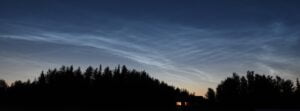Noctilucent clouds outburst strongest in 15 years, NLCs seen as far south as Washington State and Oregon
A sharp spike in the frequency of noctilucent clouds was detected at the end of June 2022. This is the largest NLCs spike in the last 15 years.

A sharp spike in the frequency of noctilucent clouds was detected at the end of June 2022. This is the largest NLCs spike in the last 15 years.
Noctilucent clouds are still bright and abundant 2 months after the start of the 2021 northern hemisphere season (May/June – August), and at the highest latitudes they are setting records, Dr. Tony Phillips of SpaceWeather.com noted in his latest NLC update….
A major outbreak of noctilucent clouds (NLCs) was reported over Europe, including France, Spain, Germany. NLCs over these latitudes are considered rare, according to night sky enthusiasts, as these clouds are typically seen over higher latitudes. Last week, NLCs…
New data provided by NASA's AIM (Aeronomy of Ice in the Mesosphere) satellite mission shows that the first noctilucent clouds (NLCs) of summer have been trending earlier since 2007, when the spacecraft was launched. Each year, NLCs first appear in the Arctic and…
Noctilucent clouds (NLCs) have been spotted over Poland, Czech Republic, Canada, and Scotland, among other countries, on May 25 and 26, marking an early start to the northern hemisphere's 2021 NLC season. The clouds are rapidly intensifying. In only four days…
Noctilucent clouds (NLCs) have returned to the South Pole and made a very rare appearance over Argentina more than one month after the beginning of the southern hemisphere season. Gerd Baumgarten of Germany's Leibniz-Institute of Atmospheric Physics, whose…
Noctilucent clouds (NLCs) over the South Pole remain missing as of December 29, 2020– an unusual occurrence as the clouds are expected to appear in the middle of the month. The southern stratosphere seems to think it's winter. In early December, Dr. Tony…
Noctilucent clouds (NLCs) over the South Pole are missing this year, but consider it only the tip of the iceberg, Dr. Tony Phillips of the SpaceWeather said. Missing NLCs is just one of the curious weather patterns currently underway at the southern end of our…
Rare dark red noctilucent clouds appeared over Vallentuna, Sweden on July 25, 2020, and were recorded by P-M Heden. This type of NLCs is rare and not fully understood, Dr. Tony Phillips of the SpaceWeather.com reports. Research in the 1970s revealed that much of the…
Observers across Europe, from Scandinavia to the Adriatic coast, are reporting major noctilucent clouds (NLC) outbreak on July 5 and 6, 2020. The outbreak comes on the heels of July 4th sighting over southern California, U.S. — where in 2019 a record was set for…